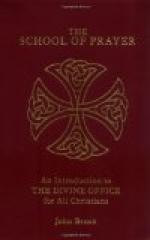From Compline of Holy Saturday, inclusive, until None of the Saturday after the feast of Pentecost, inclusive, the “Regina coeli” is said. It is a very old composition, but its author is unknown. Some authors attribute it to St. Gregory the Great (590-604). Others, following a venerable tradition, say that the three first lines were the composition of angels, and the fourth, Ora pro nobis Deum, alleluia, was added by Pope Gregory. The legend tells us that when in the year 596 Rome was desolated by the plague, Pope Gregory the Great exhorted his people to penance and prayer, and carrying in his hands the picture of the Blessed Virgin, said to be painted by St. Luke, he led them in procession to the church, Afa Coeli, on Easter morn. When the procession was passing Adrian’s Mole, angel voices were heard chanting the Regina Coeli, and the Pope astonished and rejoiced added the words “Ora pro nobis Deum, Alleluia,” and immediately a shining angel appeared and sheathed his sword, the plague ceased on that very day (Gueranger, Liturgical Year, “Paschal Time,” Part I., p. iii; Duffy, Dublin). Attempts at translation have been indifferent.
From the first Vespers of the feast of the Most Hoiy Trinity to the None of the Saturday before Advent, the Salve Regina is said. The authorship was assigned to St. Bernard (1091-1153). But scholars reject this theory. It is assigned to Petrus de Monsoro (circa 1000) and to Adehemar, but the claims of both are doubtful. In 1220 the general chapter of Cluny ordered its daily chanting before the high altar, after the Capitulum. The use of the anthem at Compline was begun by the Dominicans about 1221 and the practice spread rapidly. It was introduced into the “modernised.” Franciscan Breviary in the thirteenth century. The Carthusians sing it daily at Vespers; the Cistercians sing it after Compline, and the Carmelites say it after every Hour of the Office. It is said after every low Mass throughout the world. It was especially obnoxious to Luther, who several times denounced it, as did the Jansenists also. It is recorded in the lives of several saints that the Blessed Virgin, to show her love for this beautiful prayer, showed to them her Son, at the moment they said “Et Jesum ... nobis post hoc exilium ostende.”
Speaking of these antiphons of the Blessed Virgin, Battifol, in his History of the Roman Breviary (English ed.), writes: “We owe a just debt of gratitude to those who gave us the antiphons of the Blessed Virgin ... four exquisite compositions, though in style enfeebled by sentimentality.”
After the antiphon of the Blessed Virgin the versicle and response are said. Then Oremus and prayer “Omnipotens sempiterne Deus ... Divinum auxilium ... Amen,” are said. Then the Pater Noster, Ave and Credo are said silently, and this finishes the Hour. The prayer Sacro-sanctae et individuae.... V. Beata viscera ... R. Et beata ubera ... Pater Noster and Ave are generally added though not of obligation. They are to be said kneeling. The reading of this well-known and oft-repeated prayer, in its English translation, may bring fresh and fervent thoughts to priests, for it is a sublime prayer:—




